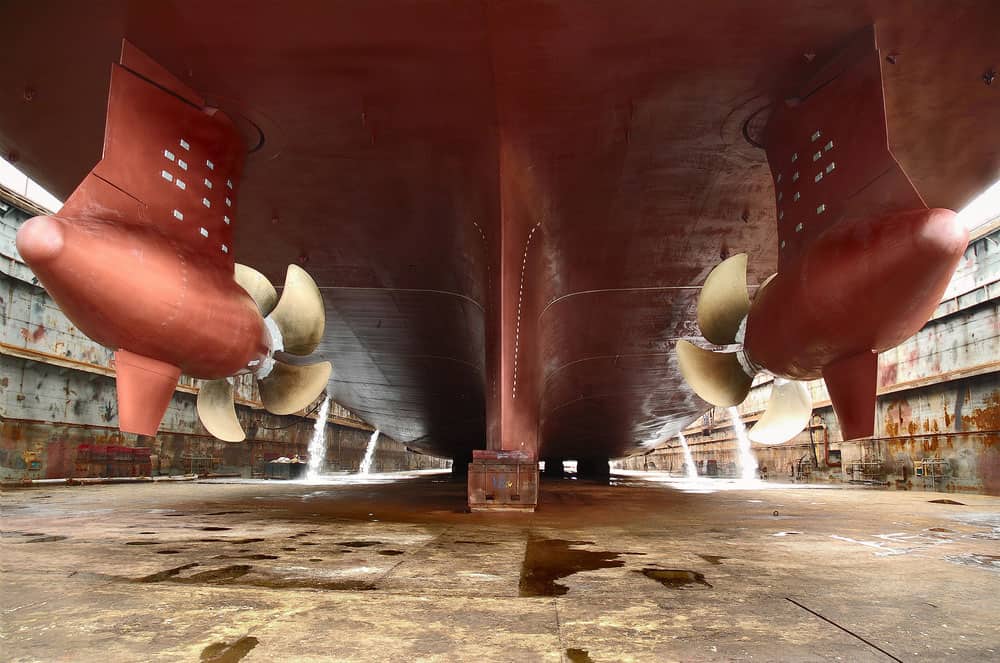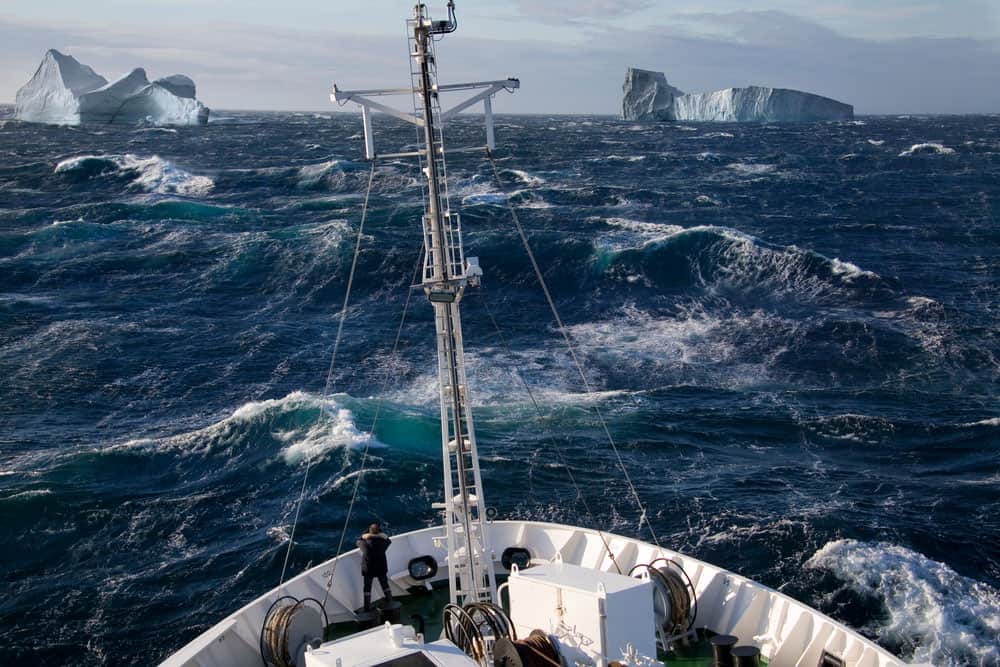I’ve lost count of the number of times I’ve walked past the ship from the dock and looked at that red section of the hull. The water looks so shallow. Surely there should be more of the ship under there to counter-balance the 15 or so decks above me? So, how much of a cruise ship is under water? Not much it would appear!
Icon of the Seas when it launches, will be the largest and tallest of all the cruise ships in the world, and it will have 19 decks! Don’t cruise ships that tall not just topple over?
How does the largest cruise ship on the planet even float? Let’s find out.
It seems that the first thing I had to learn was the concept of buoyancy. Basically all about learning how ships float. Yes, I know, this also takes me back to whatever grade of school education, but stick with me.
So far so good. Are you still following along?
Let’s start with the original question. How much of a cruise ship is under water?
Well, did you know that on average, only about 10% of a cruise ship is underwater? This equates to around 30 feet for larger cruise ships like the Wonder of the Seas. That’s the size of just 5 adults standing on top of each other.
Okay. Let’s get into more detail.

How Do Cruise Ships Float and the Reason Cruise Ships Have Flat Bottoms
Fortunately, I have discovered that there are a few key factors that ensure cruise ships don’t sink.
Hull Shape and Design
The hull of a typical ship is either be U-shaped or V-shaped, which helps to displace as much water as possible and create upward pressure, known as buoyancy. Larger cruise ships typically are U-shaped. In fact, many cruise ships have flat bottoms, although will of course narrow as you approach the front of the ship. This ensures less drag as the ship moves through the water.
What Keeps a Cruise Ship From Tipping Over?
The design of the hull helps to distribute the ship’s weight more evenly, which keeps it stable in the water and stops the ship from capsizing or tipping over. The placement of decks, ports, and the bow also plays a role in the ship’s stability and buoyancy.
Buoyancy And Displacement
According to Archimedes’ principle, an object that is placed in water will displace an amount of water equal to its own weight. Ok hands up if you don’t remember Archimedes and his “Eureka!” moment when he was in the bath?
This is what keeps a ship afloat. The ship’s mass is spread over a large area, including a wide hull and overall surface area, this pushes on a wider area of water and offers more of an upward force, keeping it afloat. The technical term for this is buoyant force or buoyancy.
Surprisingly it seems that when thinking about how much of the ship sits in the water, it would appear to be not a lot!
Stabilizers and Ballast Tanks
Now it’s not just about keeping the ship afloat. To prevent a cruise ship from toppling over, it must maintain a low center of gravity. This is achieved through the use of stabilizers and ballast tanks.
Stabilizers are fins (or wings) that extend from the hull of the ship and help to reduce the side-to-side movement of the ship. Ballast tanks are compartments that are filled with water to help adjust the ship’s weight and balance. By filling or emptying these tanks, the ship’s gravitational center can be adjusted to keep it stable in the water.
Unfortunately, those stabilizers only work for side-to-side motion – front-to-back rocking is very hard to manage.
[Related Post: How Much Does a Cruise Ship Weigh?]
How much of A cruise ship is under water?
As a curious traveler, I have always wondered how much of a cruise ship is below water. After some research, I found out that approximately 10% of a cruise ship’s overall height is underwater, which equates to about 30ft for large cruise ships.
The Waterline
The waterline is the point where the hull of the ship meets the water’s surface. It is the part of the ship that is always in contact with the water. The height of the waterline varies depending on the weight of the ship and the amount of cargo it is carrying.
That’s why you’ll see the amount of red hull that sits out of the water or deep in the water varies from the first day of your cruise to the last (no matter how many extra Lobsters you had at the Captain’s Dinner!).
How much water does a cruise ship hull displace?
The superstructure is the part of the ship that is above the waterline.
This includes the cabins, restaurants, swimming pools, waterslides, mini golf courses, bumper cars and all manner of crazy things that cruise ships now have on board.
The superstructure is usually built with lightweight materials to reduce the weight of the ship and improve stability.
A lot of the engineering crew members will work below the waterline. but they are still above the “keel”, which is the lowest point of the ship. Think of the keel as the backbone of the ship. It also provides stability in heavy seas allowing it to easily move through the water. Of course, it is also paramount to ensuring the cruise ship floats

Are there any parts of a cruise ship or Cruise Cabins Under water?
As I was researching this article, I wondered if there were any cruise ships that had cabins that were below the waterline. Or any public areas?
After some digging, I found out that there are no underwater cabins for passengers on any of the main cruise lines. However, on some cruise ships, the crew cabins are located below the waterline.
On the few cruise ships that do have decks that are under the waterline, these areas are usually reserved for staff accommodation, air conditioning units, the engine room, laundry, and of course, the jail! (Fortunately, I’ve never visited it!).
These areas are out of bounds to passengers for safety reasons and to ensure that the ship runs smoothly.
So, even if you wanted to, you won’t be able to book an underwater cabin on your next cruise. Cruise ships are amazing pieces of engineering, but this ain’t a glass-bottomed boat LOL
How far can a Cruise Ship Tip Over? What stops the Ship from Tipping?
Okay, we’ve figured out how it floats. What about tipping? How far can it list to one side over before it capsizes?
I’ve had personal experience of this. And it’s a LOT! We were on a Royal Caribbean ship coming out of Naples harbor in a heavy storm. The Captain had warned up via tannoy that the ship would tilt heavily to one side, due to the strong winds and the 90-degree turn he had to execute on leaving the harbor.
Well, oh boy did it tilt! We were in the main dining room and dinner plates and cutlery all started to slide. On the large windows on one side of the dining room, all I could see was the sea. On the other side just the sky. It was crazy. To me, it felt like about 45 degrees but in reality, it was a lot less.
In normal operations, cruise ships may actually tilt up to 10-15 degrees without any issues. This is because the ship’s weight is evenly distributed and the gravitational center is very low.
To prevent tilting issues and to stop cruise ships from sinking, they have a variety of safety features. For example, they have ballast tanks that can be filled with water to help stabilize the ship by adding more weight at the bottom.
So while it’s possible for a cruise ship to fall over, it’s highly unlikely in normal operations.
Cruise ships are designed to be very stable and have a low center of gravity. They also have a variety of safety features to prevent capsizing.
So, next time you’re on a cruise, don’t worry about the ship capsizing, even if you are in heavy seas. Just sit back, relax, have another drink, and enjoy the ride!
What Happens When a Cruise Ship Tips Over? How do they keep a cruise ship upright?
Okay, so I’ve told you that a cruise ship is not likely to ever capsize. But I can hear the nervous ones amongst you: “But what if it did?”.
Well, apparently it depends on several factors, including the cause of the loss of stability, the size of the ship, and the protection mechanisms in place.
Rogue Waves and Hurricanes
One of the main dangers that could cause a cruise ship to capsize is due to rogue waves and hurricanes. We’ve all watched The Poseidon Adventure!
These natural disasters can cause massive waves that could in theory capsize even the heaviest boats.
Fortunately, modern engineering makes ships much more stable by making them wider and lower in the water. The technology used to manage weight distribution via ballast tanks is also far superior and more responsive than it used to be.
Additionally, cruise ship also have monitoring systems and radar that are much more sensitive to weather issues, so that the Captain can make the ship navigate around any bad weather areas.
The Titanic Disaster
The Titanic disaster is a tragic example of what can happen when a ship is not designed to withstand harsh conditions.
The Titanic was not equipped with enough lifeboats to evacuate all the passengers in case of an emergency. As a result, many people lost their lives when the ship sank after hitting an iceberg. Since then, regulations have been put in place to ensure that all ships have enough lifeboats for everyone on board.
(Ever wondered how big Titanic compared to cruise ship behemoths like Wonder of the Seas? Read this to find out.)

How much of a cruise ship is underwater? Here is the answer
So there you have it. The answer to how much of a cruise ship that is underwater varies depending on several factors.
It’s all about the size of the ship and the amount of load being carried. But in general, it is around 10% of the ship’s height or around 30 feet for the biggest cruise ships out there.
The main thing to remember is that the amount of the ship that is underwater is not a cause for concern. The technology that marine engineers have developed is incredible, and cruise ships are designed to remain stable and safe, even in rough waters.
So if you are in any way a nervous cruiser, don’t be! The next time you look at a cruise ship in dock, take a good look at that hull. Modern mega cruise ships are marvels of Engineering and safety at sea is the number one factor in their design.
Need more Cruise Tips and Guides? Head over here.